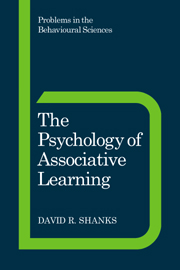3 - Prototype abstraction and instance memorisation
Published online by Cambridge University Press: 26 January 2010
Summary
In the last chapter we established that, to a first approximation, the human learning system behaves normatively. In attempting to answer the question ‘What is the system doing?’ (the first of our three questions), we have found that associative learning corresponds reasonably well to the prescriptions of contingency theories. In reaching this conclusion, we have remained agnostic about how the system actually works; all we have shown is that the behaviour it yields in associative learning tasks is roughly what a statistician utilising the notion of contingency would prescribe. In the present chapter we begin our consideration of how the system achieves this end. Here, we ask the second question, ‘What sort of information is acquired during the course of a learning experience?’. In the next chapter, we will ask exactly how at the mechanistic level this information is acquired.
We begin by considering the phenomenon of generalisation, which represents one of the principal challenges to any theory of learning. Having learned something about one stimulus, how will acquired knowledge determine responding to some further stimulus? Generalisation is of interest not just because it is something we would like our theories of learning to explain, but also because it provides data that may tell us about the way in which information is represented. Two quite different views of the form of information underlying associative learning have been embodied in prototype and instance theories, and for these theories generalisation is a central issue. They attempt to describe how learning takes place in situations where there is considerable stimulus variation from trial to trial, and where the ability to generalise to new stimuli perceptibly different from ones already encountered is essential.
- Type
- Chapter
- Information
- The Psychology of Associative Learning , pp. 61 - 103Publisher: Cambridge University PressPrint publication year: 1995



